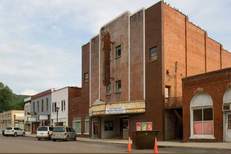 Click image to enlarge.
Click image to enlarge.
 Click image to enlarge. Click image to enlarge. It's a Wonderful Life, The Big Sleep, and The Best Years of Our Lives were among the top movies of 1946, the same year the Cricket Theater opened in Collinsville. It was also the year credited by film historians as the highwater mark for film-going, as more than eighty million people attended the movies every week—almost sixty percent of the total population. The sixty-thousand-dollar, eight-hundred-seat theater was built just as television was emerging in the decade following World War II. Boasting “the largest chairs, modern rest rooms, and year-round air conditioning,” the building is typical of the streamlined designs of the late movie palace era. Like most small-town movie houses, the Cricket eventually succumbed to the competition from television and closed its doors in October 1964. The theater later reopened for a time but has mostly been dark in recent decades. A portion of the roof recently collapsed, daunting the efforts of the Collinsville Historical Association, which recently purchased the property and is trying to raise ninety thousand dollars for the roof repairs alone. Only time will tell if the old Cricket marquee will once again blaze with lights and bring back some of its former excitement to Collinsville’s main street. UPDATE: The Collinsville Historical Association purchased the building and has been working to restore it to working condition. Read more from the Times-Journal.
0 Comments
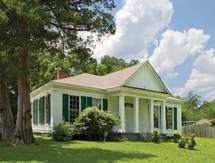 Click image to enlarge. Click image to enlarge. The Kelly-Stone-Hill House is one of the few pre–Civil War structures remaining in Pickens County. Listed in the National Register of Historic Places, this residence is a good example of the type of vernacular Greek Revival–style cottage once found in towns and villages across the Deep South. In 1830 the federal government gave Pickens County eighty acres for its county seat. Located close to the courthouse square, the Kelly-Stone-Hill house was one of the first dwellings built in the town of Carrollton. The house is threatened by deterioration, and its owners are looking for a buyer who would be willing to restore it. Bankhead-Shackelford House, Courtland, Lauderdale County, c.1880-1900 (Places in Peril 2010)10/25/2010 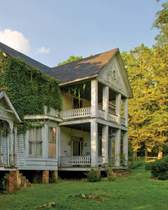 Click image to enlarge. Click image to enlarge. A key architectural landmark of the Courtland National Register Historic District, the Bankhead-Shackelford House was perhaps the most significant residence built in this planter community during the post-Reconstruction era. This house dates between the prosperous antebellum years and the renewal of cotton prosperity that occurred between 1900 and the beginning of the First World War. Accordingly, the house attests to a tendency for older forms and layouts to linger underneath decorative detail that changed with the tide of fashion. Today the house speaks to the architectural conservatism of Alabama’s nineteenth-century agrarian gentry. Unoccupied for many years, the house has been minimally maintained. For this warm and enticingly livable place, a thoughtful restoration would not only preserve this important piece of Alabama’s architecture, but serve as a catalyst for neighborhood revitalization. 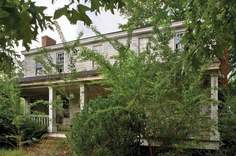 Click image to enlarge. Click image to enlarge. Home to one of Alabama's most prominent families, whose political leadership in the U.S. Congress shaped the history of our nation, this house was built by John Greer Bankhead in the 1850s and was the birthplace of John Hollis Bankhead, one of Alabama’s most influential congressional representatives. Also born in the house were his two sons, John Hollis Bankhead II and William B. Bankhead, both of whom were elected to Congress, where they were strong proponents of President Roosevelt’s New Deal legislation. The property owners desire to retain the land that has been in their family, despite having no use for the house. A creative solution undoubtedly exists that would resolve the dilemma, but to date no interested entity or individual has come forward with a viable plan. 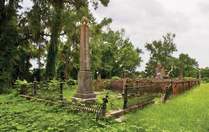 Click image to enlarge. Click image to enlarge. Situated on a high bluff overlooking Lake Eufaula, sheltered by the moss-draped limbs of tall oak trees, the Shorter Cemetery sits on a five-acre plot near downtown Eufaula. The Shorter Cemetery is the burial place of Barbour County’s prominent Shorter family, whose descendants guided Alabama during its most challenging periods. John Gill Shorter, Alabama’s first Civil War governor, rose to political prominence during the 1850s, when he emerged as a fierce defender of slavery and advocate of economic development and diversification in support of southern nationalism. In the 1890s, Reuben F. Kolb, nephew of Governor Shorter and grandson of Reuben C. Shorter, patriarch of the Shorter family, rose to political power as an agrarian reformer. Denied the Democratic nomination for governor in 1890, Kolb ran again in 1892 and as a Populist candidate in 1894 on a platform to expand the political power of blacks and poor whites. |
Alabama's Endangered Historic LandmarksEach year since 1994, Alabama Heritage has highlighted threatened historic sites throughout Alabama. The “Places in Peril” list has identified more than 215 imperiled historic resources throughout the state, and is compiled by the Alabama Historical Commission and the Alabama Trust for Historic Preservation. The locations highlight the results of deferred maintenance, perceived obsolescence, development pressures, and lack of funding—forces that now more than ever threaten our cultural legacy. But awareness is a powerful force, too, and can cultivate a renewed determination to be responsible stewards of our heritage. For more information, visit the AHC or the ATHP websites. Alabama Heritage is proud to bring to you a selection of the places designated as perilous. Please keep your comments to information relevant to the featured place in peril. Alabama Heritage reserves the right to delete any comment that we deem inappropriate. Archives
May 2024
|
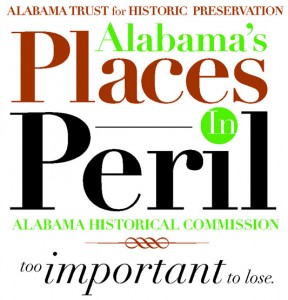
 RSS Feed
RSS Feed